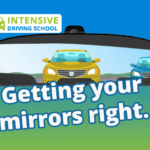Getting on the road can be a long and overwhelming journey, specifically when thinking about the driving test and how to pass it. But you must definitely believe in yourself, there are over 45 million drivers on the road in the UK and with time and hard work, you’ll be one of them.
But where should you begin your journey? We’ve put together a thorough guide to get you from beginner to pro and out on the road before you understand it!
Action 1– Where should you begin?
Firstly, before you even begin considering driving lessons you’ll be required to secure yourself a provisional driving licence.
What is a Provisional driving licence?
A Provisional driving licence will allow you to:
Start learning how to ride a moped or light quad bike from the age of 16
Start learning out how to drive a car from the age of 17 with the following exception:
If you’re getting Individual Self-reliance Payment (PIP) you can learn to drive a vehicle and take a test when you’re 16 if you’re getting, or have actually made an application for, the mobility part of PIP.
This does not mean that you can now drive around on your own. A provisional licence only permits you to drive when in the vehicle with a certified driving instructor or another person that is over the age of 21 and has been driving for a minimum of 3 years.
Enjoyable reality: A provisional licence also doubles up as a form of ID!
How do you get a provisional licence?
To start with, in order to apply for your provisional licence you’ll need to be:
At least 15 years and 9 months old
Able to check out a number plate from 20 metres away You’ll then require the following for the application itself:
To offer a legitimate form of ID; typically a passport
To offer addresses for where you have lived over the last 3 years
Your National Insurance number if you know it
Pay via credit or debit card
Simply go to the provisional driving licence section on the GOV UK website to start your application. It normally takes around a week for your provisional licence to arrive.
Action 2– Arrange your lessons
Now it’s almost time to start your lessons, you’ll want to have a think of your objectives and affecting aspects.
When do you want to have passed your test by?
How much money and time do you wish to invest into your lessons every week?
Selecting these will help you then go forwards and choose the very best type of lessons for you and your objectives.
What are intensive courses?
Intensive courses, otherwise known as ‘refresher courses’ are a terrific alternative if you’re looking to pass your test in the quickest time possible.
These are normally versatile courses of extended one-on-one tuition that work with an instructor to produce a versatile lesson plan with the objective of passing your driving test as rapidly as possible.
Pros:
Can pass in as low as a week from a complete beginner.
Mainly versatile and will work to your schedule.
The expenses of your theory and tests are consisted of in the package.
Cons:
They do include a high preliminary expense.
They require a good deal of focus, commitment and devotion.
You require to make sure you have a free amount of time to finish.
Some individuals may discover the quick paced, extensive environment uneasy.
If this seems like it meets your goals, discover more info on extensive courses and what IDS can offer. If not, it’s most likely that scheduling standard lessons will be your best choice.
How many lessons should you have a week?
The typical learner requires 45 hours of driving lessons, in addition to 20 hours of practice to pass the driving test. This varies from individual to person, so although this is an excellent figure to utilise as a benchmark, you must take it at your own rate and not compare yourself to others.
Generally speaking, having one lesson a week is what the typical learner selects to do. But really there is no set quantity of lessons you ought to be having each week. Pick what suits you best!
Learn more about the various kinds of lessons that IDS offers
Manual vs Automatic
While automatics are simpler to drive, you’ll only have the ability to lawfully drive automatics. You’ll be unable to legally drive a manual vehicle if you have an automatic drivers licence.
Unless you’ve got disabilities preventing you from driving a manual, a manual licence will provide you more flexibility in the future and you can normally discover much cheaper manual vehicles for your very first car.
Action 3– Choosing the right driving instructor for you
Choosing the best driving instructor for you is important. The most crucial thing when it concerns selecting an instructor is choosing someone that makes you feel comfortable when your in the drivers seat as significantly, you’re most likely going to be investing 40 hours in a car together!
It may be appealing to get a relative or buddy to teach you to drive, as you’re currently comfortable with them and they probably wouldn’t charge you anything (or much) for the lessons. As tempting as that might be, a specialist will have a lot more experience teaching and will know what’s expected from you in the test.
Fully qualified instructors will also have their own vehicle to teach you in which will have dual controls which permit the instructor to take control of or assist with the controls if they feel you need it at any point.
Where should you search for a driving trainer?
There’s multiple ways of discovering a driving instructor. Many people select instructors based on suggestions from friends and family, however you can also check out the Authorised Driving Trainer page on the DVSA site.
Intensive Driving School provides a wide range of driving instructors in order to match any specific needs that students might have such as:
Male/Female driving trainers
Foreign language driving instructors Automatic/Manual driving instructors.
Step 4– Beginning your driving lessons
Now that you’ve picked your driving instructor and booked your driving lessons, it’s time to cover some tips that will help you in your learning process.
What should you bring with you to your very first driving lesson?
Your provisional license
A favourable mindset
Highway code understanding (beneficial, but not needed).
What shoes should you use when driving?
The main point is wearing comfortable shoes that you more than happy to drive in. Avoid heavy shoes and stick to thin shoes that enable you to feel the pedals. Practicing in-between your lessons.
Study in-between your lessons.
It’s great to keep practicing up until your next lesson happens as this will help you end up being more comfortable driving in the car.
You can go out and practice driving with another driver over the age of 21 that has been driving for over 3 years. You’ll likewise require to both be guaranteed on that car!
Studying for your theory test in-between lessons is a must.
This will assist you prepare for taking your theory test and will likewise help out when you’re on the road having your lessons.
Mock tests.
Although this is most likely something your trainer will recommend, why not ask to work some mock tests into your lessons?
This will help seal your current knowledge and will help you become more comfortable and confident when you reach the genuine test.
Step 5– Taking your theory test.
As soon as you’ve been learning to drive for a little while, your instructor will probably advise that you book your theory test. You’ll be finishing this whilst doing your driving lessons, so as mentioned formerly, you’ll need to be studying in between lessons!
What to expect in the theory test.
The test will be made up of 50 multiple-choice questions and after that a hazard perception test.
You’ll have 57 minutes to finish the multiple choice test and will need to score 43 out of the 50 to pass. Before the test starts you’ll be given instructions on how to finish the test, so make certain to focus. You’ll then be offered the opportunity to take a practice session so that you can get used to the format of the test.
For the hazard perception test, you’ll have to view 14 video clips and click a mouse whenever you identify a hazard developing. You’ll need to score 44 out of 75 to pass. See our top tips on how to pass your theory test.
It’s likewise worth noting that during covid-19, there will be some additional safety precautions in effect at your theory test centre. You can find all information regarding this on the GOV UK website.
The practical driving test.
Now that you have actually had plenty of lessons, passed your theory test and got the consent from your trainer, it’s time to handle the practical driving test.
How to book your practical test.
You can book your driving test online through the practical test section of the main GOV UK website. There is also an alternative to look for test cancellations on the GOV UK website. This will possibly allow you to book on an earlier test if someone cancels theirs.
Taking your driving test!
Now it’s time to take your driving test, you’ll need to ensure you bring your:.
Theory test pass certificate.
Provisional driving licence.
Confidence!
The driving test typically takes around 40 minutes and is consisted of the following:.
Sight check – Firstly, you’ll be asked to read a number plate of a random car from 20 metres away to inspect your eyesight. If you can not do this, you will not be able to advance with the rest of the test.
‘ Show me tell me’ questions – Secondly, your examiner will ask you two ‘tell me’ concerns about car checks that you ought to perform prior to driving. Later on in the test, while you are driving, your examiner will ask you a ‘show me’ question. You can discover a list of these questions on the GOV UK site.
General driving ability – Next, you’ll get to the driving part of the test. You’ll be advised to drive down numerous roads and traffic conditions and your examiner will provide you instructions that you require to follow, you will not drive on the motorway.
You will need to carry out 20 minutes of Independent driving on your driving test. This shows competence and how you can handle situations on your own.
As soon as you have actually finished your test and showed up back at the test centre, the examiner will go over his/her observations with you and you’ll be given a pass or fail certificate.
What happens if I slip up on my test?
You can make up to 15 driver faults (called minors) and still pass your test. You will also fail if the mistake you make is deemed ‘major’ or ‘hazardous’ by your examiner. Any among these will result in an immediate fail. Learn the 10 most common reasons pupils fail a driving test.






